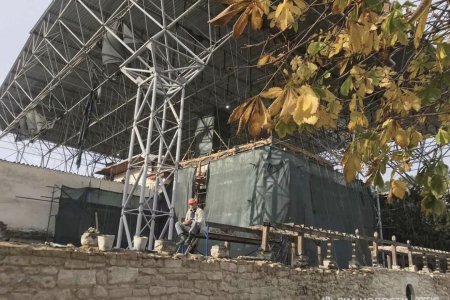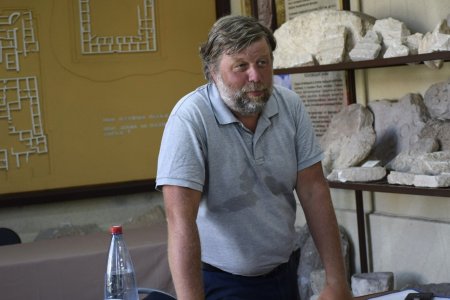
The Russian occupiers have totally destroyed a priceless fresco from the Khan’s Palace, or Hansaray, in Bakhchysarai, a monument of enormous historical and cultural significance for Crimean Tatars and for Ukraine. Russia’s invasion of Crimea in 2014 suspended any progress on moves already underway to have the Khan’s Palace declared a UNESCO World Heritage Site. The aggressor state’s barbaric vandalism since 2016 has now made it unlikely that Hansaray would receive the status it deserved even after Crimea is liberated.
Russia has crushed all independent media in occupied Crimea, and has persecuted those Crimean Tatar activists who spoke publicly about the devastation being caused by so-called ‘restoration’ work. This time, however, it was reports in Russian-controlled media that the Association of Reintegration of Crimea cited on 4 March 2025 as their source of information. It was claimed in these reports that the ordinary painters employed in this alleged ‘restoration’ of the upper part of the palace, had totally destroyed the historic wall fresco on the Khan’s Palace. They had, supposedly, “thought that it was simply old plaster work.” The reports assert that these individuals had been told to get rid of the old covering and, when they came upon the fresco dating back to the 16th – 18th century, they ‘got rid’ of that as well. The Russian-controlled sources acknowledge that the fresco cannot be restored, and “cynically propose ‘painting it again’”
Elmira Ablyalimova, former Director of the Bakhchysarai Historical Cultural Reserve, says that the new destruction spells the loss of valuable works of art from the Crimean Khanate of the sixteenth to eighteenth centuries. “This is not just the loss of the monument’s authenticity, but also a loss of sources for future research, the loss of valuable examples of the fine arts of the 16-18 century Crimean Khanate, few of which have been preserved.” The fresco, with its designs, ornaments and calligraphy were typical for palaces and mosques of the 16th century. Very little research has been carried out into the artists involved in such frescos, and the loss of the original work will also make it impossible to study the techniques and pigments that were used and their individual stylistic features.
Ablyamilova is convinced that such actions are deliberate. This is not the first time she has suggested deliberate intent, nor is she alone in suspecting this. Responsibility for the destruction, she stresses, lies with those who agree such actions, who consciously provide permits for construction work on the parts of the Khan’s Palace complex. She adds that work has been carried out since 2016 which has nothing to do with restoration, or with providing support for the complex. “This is simply building work, reconstruction which, most unfortunately, leads to irreparable losses.”
UNESCO’s brief description of the Khan’s Palace in Bakhchysarai [or Bagçesaray Palace of the Crimean Khans] called it “a compact architectural ensemble consisting of 17 buildings and 9 inner closed courtyards” which dated back to the early 16th century. It was originally built as the main residence of the Khans of the Crimean Khanate - the state of the Crimean Tatar people. It remained “the political, religious and cultural centre of the Crimean Tatar people” until Russia’s first annexation of Crimea and the collapse of the Khanate in 1783.
The destruction which Russia tried to pass off as ‘restoration’ was first reported in 2018. It seemed clear then that one of the motives behind the wanton destruction, including the replacement of all of the original, handmade, tiles on the Palace roof with factory-made ‘old-looking’ Spanish tiles, was banal corruption. The original ties had been packed up and were probably earmarked for this or that Russian occupation official’s dacha. There has been plenty of evidence since of corruption in the allocation of major contracts to Russian companies with no experience of restoration work.
Such an approach alone would have made the barbaric destruction of authentic architecture, frescoes, etc. near inevitable. The destruction may well, however, be deliberate policy. Elmira Ablyalimova earlier suggested that Russia was consciously destroying a monument of vital importance to Crimean Tatars, one that clashed with the ‘Russian world’ ideology that Russia is using to try justify its invasion and ongoing occupation of Crimea. The centre of the Crimean Khanate does not fit well with Russia’s assiduous efforts to claim that Crimea was ‘always Russian’ and that ethnic Ukrainians are “the same people” as Russians. It should be said that the Crimean Tatars, as the main indigenous people of Crimea, also clash with Russia’s narrative, given that they, and their representative body, the Mejlis, were adamant in opposing Russia’s invasion and in affirming their identification with Ukraine.
It is no accident that so many Crimean Tatars see similar elements in the three catastrophic dates for the Crimean Tatar people – Russia’s first annexation in 1793; the 1944 Deportation and the 2014 invasion and annexation. Ablyalimova earlier noted that history was now repeating itself as it had been after the first, 1793, annexation that the Russian empire first began rebuilding’ the complex, with some of the buildings demolished, walls painted, etc. After Stalin’s Deportation of the entire Crimean Tatar people in 1944, most monuments and places of historical and cultural significance for Crimean Tatars were destroyed. Now Russia, as occupying state, is finishing this destruction.
A brief list of ways in which Russia is not restoring, but destroying the Khan’s Palace (see links below for more details):
the above-mentioned removal of the original Tatarka tiles and replacement of them with factory-made titles;
the completely unnecessary replacement of all of the oak beams on one of the roof coverings by glue composite planks put together using OSB {oriented strand board) technology (a solution rather like plywood!);
the use of hydraulic drills and other heavy construction equipment, with this causing vibration and leading to cracks in the walls and wall paintings and finishes being damaged or completely lost. In February 2022, for example, it was learned that a large crack has appeared on the wall of the Svitsky Corpus [Retinue Corps];
parts of 16th century walls under the roof of one of mosques were broken off;
authentic stones were removed and simply left lying around, as though rubble;
in December 2022, Ablyalimova reported that the roof of the famous Golden Cabinet of the Khan’s Palace had been dismantled, together with the stained glass windows;
See:
Russia causes irreparable damage to 16th Century Crimean Tatar Khan’s Palace in occupied Crimea
‘Closed for Destruction’: Russia is digging up 16th Century Crimean Tatar Khan’s Palace )



